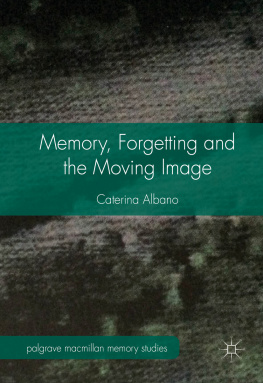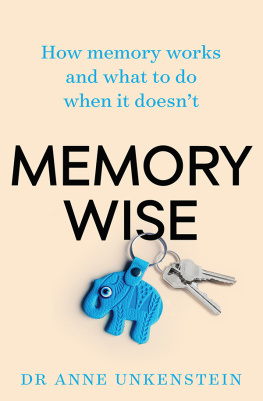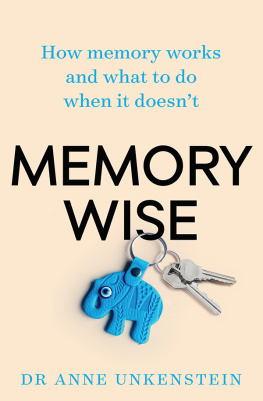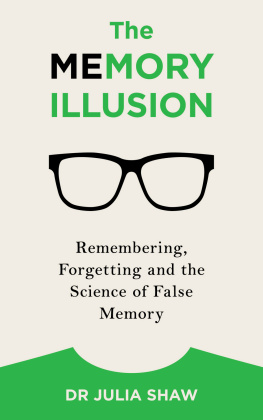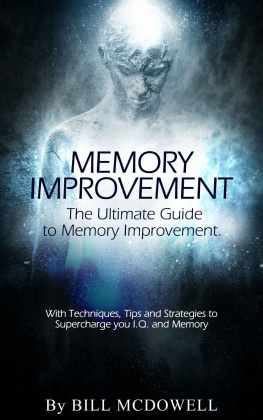1. Memory, Modernity and the Moving Image
No sooner had the warm liquid mixed with the crumbs touched my palatewrites Marcel Proust in Swann s Way (, p. 15). The Oedipus complex and Prousts petite madeleine are indeed indicative of modernitys broader reformulation of memory both across psychological sciences and culture at large. This entailed an original theorization of forgetting as inherent to remembering and a questioning of the unsettling impinging of the past onto the present for the individual and society alike. Prousts passage already posits the difficulties that forgetting brings to remembering. Although behind the taste of the madeleine lies the image, the visual memory linked to it, the memory itself struggles to reach consciousness, remaining obfuscated and ungraspable. A question lies behind the involuntary recollection of Prousts protagonist:
Will it ultimately reach the clear surface of my consciousness, this memory, this old, dead moment which the magnetism of an identical moment has travelled so far to importune, to disturb, to raise up out of the very depth of my being? (Proust , p. 53)
The moment of remembering is also an encounter with what was forgotten and had remained unremembered. It is an encounter with the past through an unfamiliar trace that emerges unsolicited and unexpectedly. Beyond both Prousts petite madeleine and Freuds Oedipus lies what concerns remembering and forgetting alike. In the words of German psychologist Hermann Ebbinghaus,
Mental states of every kind, sensations, feelings, ideas, which were at one time present in consciousness and then have disappeared from it, have not with their disappearance absolutely ceased to exist. Although the inwardly-turned look may no longer be able to find them, nevertheless they have not been utterly destroyed and annulled, but in a certain manner they continue to exist, stored up, so to speak, in the memory. (Ebbinghaus , p. 1)
It is the supposition of memories that one believes forgotten and yet are not utterly destroyed or annulled that radically reshaped the concept of memory at the turn of twentieth century, and brought to the fore one of the major difficulties still pertaining to memory today: how do we access memories that seem forgotten and what role do they play in remembering?
Todays pervasive preoccupation with memory is both rooted in and a product of the tenets that redefined it at the turn of the last century, when private and public forms of remembering were inextricably woven together, rendering the modern individualization and psychologization of memory critical to the coming into being of the psychological notion of autobiographical memory and its cultural ramifications in the late-twentieth century. Hence, our discussion of contemporary ideas of memory starts by looking at its historical roots and at the assumptions that fostered the modern reconceptualization of memory both psychologically and culturally. In order to ground the present landscape of remembering, we have to ask what the individualization and psychologization of modern memory meant and further consider the ways in which the moving image infiltrated the discourse of memory in modernity, when it became a referent for its novel theorization.
Films optic procedures were invoked at the beginning of the twentieth century to talk about memory at the boundaries of biology and culture. The impression of shifting perspectives, speed and movement characteristic of the moving image replicated the pervading impression of the rapid telescoping of images, the accelerated tempo and the multiplicity of economic, occupational, and social life that, according to Georg Simmel, denoted modernity and created the sensory foundations of mental life for the modern individual (Simmel , p. 17) . Hence, extending Gilles Deleuzes view, we can argue that with modernity film begins to stand as a way of thinking and as a way of remembering.
In considering the redefinition that memory underwent with modernity, we aim to revisit the relation between the cinematic medium and the inner film of the mind and question the implications for such reciprocity. Of particular relevance is the role that the moving image played in the attempt to authenticate puzzling psychological conditions such as hysteria and trauma. The relevance that we seek to outline resonates with the broader cultural appreciation of the moving image as a medium whose features both psychologists and filmmakers believed could be formally assimilated to those of memory. By suggesting continuity between mind and screen, modernity also maintained continuity between the memory image and the cinematic shot. The inner subjective contingency of remembering fraught with the gaps of forgetting found in the montaged image of film a correspondent on which remembering could be articulated. Such correspondence also extended from the individual to history rendering the moving image conducive for a representation of the past, which was no less fraught with amnesia and latency. The chapter outlines the modern reconceptualization of memory, and the implications of its individualization and psychologization pointing to the cultural, theoretical and experimental centrality of the moving image in such redefinition. This implies a consideration of the centrality of forgetting in psychological and psychoanalytical models of memory and a re-examination of key issues surrounding trauma and amnesia pointing to the relevance of the moving image in the assessment and theorization of such conditions.
1.1 Memory: A Modern Concept
The modern reconceptualization of memory is part of expanded historical and cultural shifts that involved new ways of perceiving, representing and narrating the self and its relations to the world. One of these shifts regards the Kantian concept of empirical self consciousness and the emergence of a science of the self (Berrios and Markov ), establishing the parameters for autobiographical memory. Common to all these approaches was an understanding of memory as an organic function, biologically determined, on which consciousness could be grounded. Indeed, modern psychology contended with the organic formation of memories and their recall in terms of sensory perception, stimulation and association at cellular level. Yet, beyond this attempt to frame remembering organically loomed another question: who remembers? Whilst asking what memories are and where they are stored entailed the physiological and psychological mapping of memory processes, to ask who remembers required a consideration of the self as both the subject and the object of remembering.
A contradiction was, in fact, already felt between the affective and emotional individuality of remembering and a purely mechanistic explanation of memorys processes in terms of excitation and retention of sensory stimuli. William James expresses such difficulty in his definition of what is a memory. James understands a memory as the representation of
the fact to be recalled plus its associates, the whole forming one object [], known in one integral pulse of consciousness [] and demanding probably a vastly more intricate brain-process than that on which any simple sensorial image depends. (James , p. 651)
James refers to the writing of French psychologist Charles Richet, who had theorized remembering by explaining it in terms of nerves sensory stimulation and retention. According to Richet, an external sensation stimulated the nervous systems and memory retained a trace of the sensory stimulation. Associations caused by other stimuli could reactivate the trace kept in memory and produce a repetition of the original sensory stimulus as a mental representation (Richet , pp. 156159). The relation between external sensation and the trace of the nerves stimulation and its later associative repetition was believed to constitute the basic principle for the formation of a mental representation (i.e. a sensory imagery), including memories. James suggests that the principle of stimulus association does not explain the concentration of information that makes up a memory as an entity that includes and exceeds the sensory imagery from which it stems. The complex conflation of sensation, emotion and knowledge that constitute a single memory, according to James, enshrines both the act of remembering and the subject that ensues from it.

